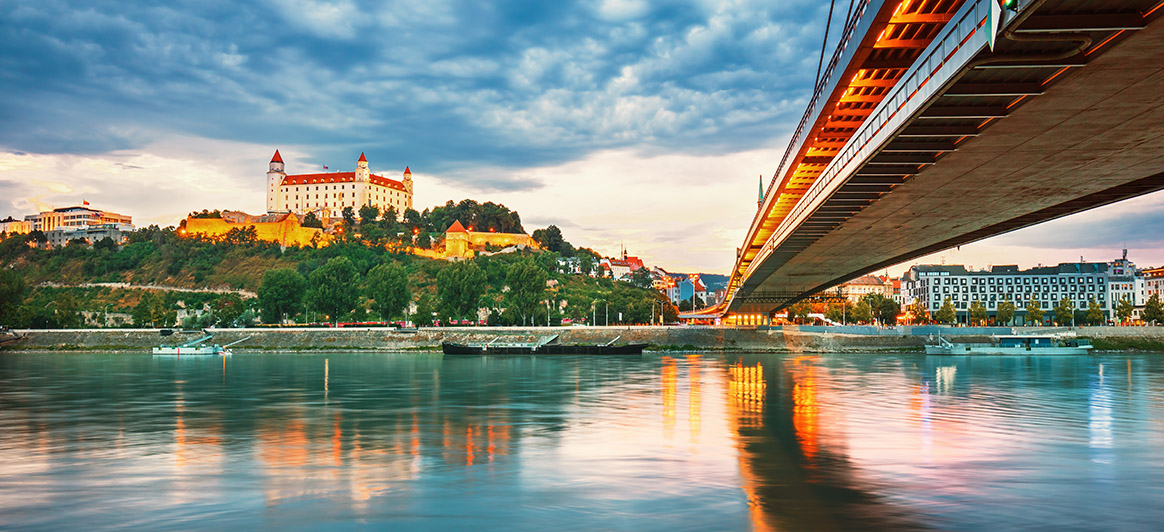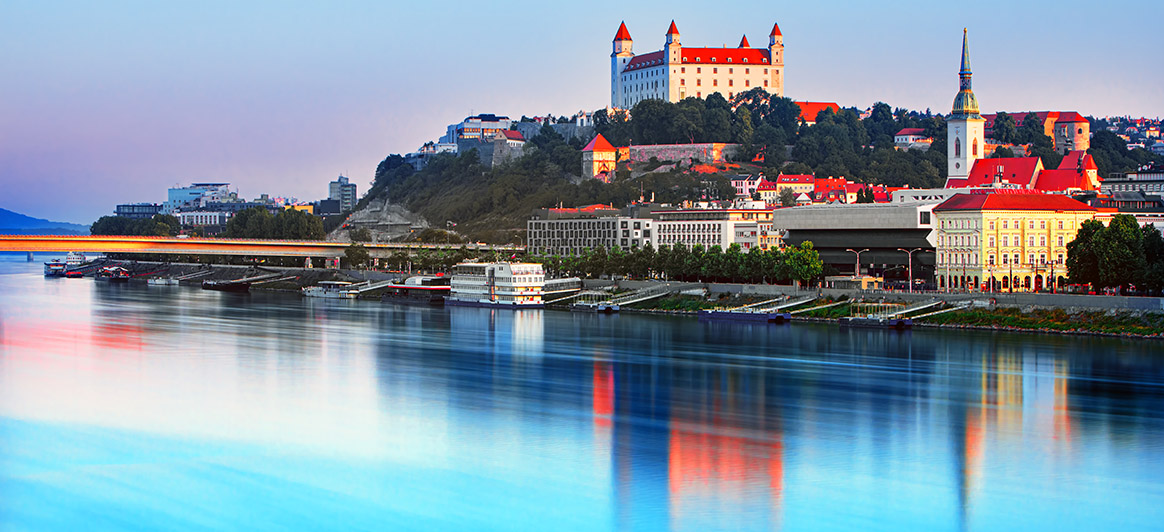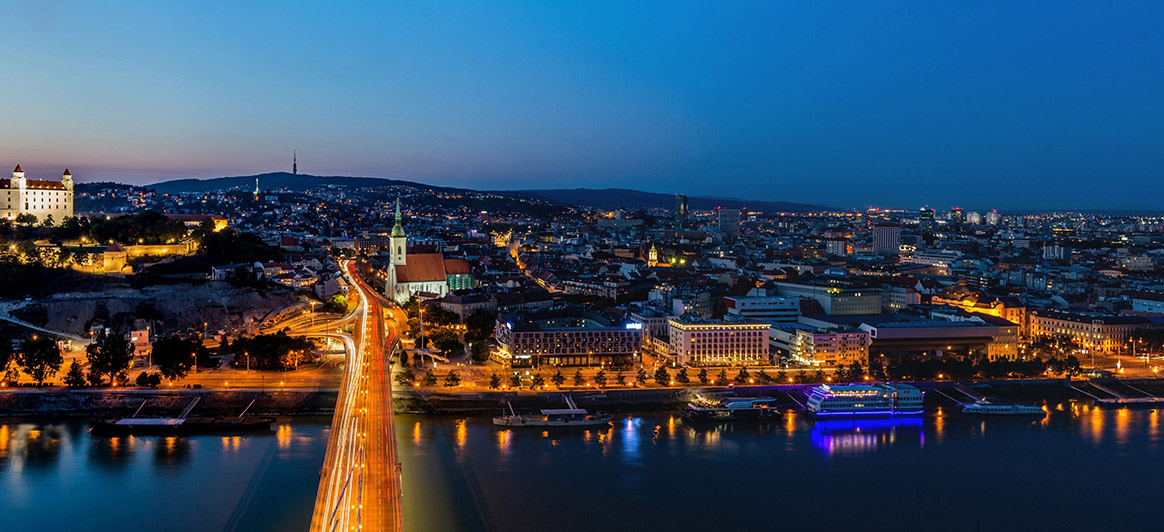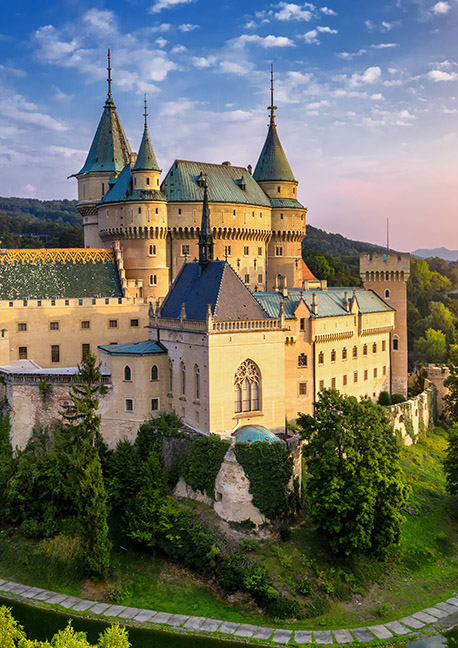
Book a Flight to Bratislava
expand_more
1 Passenger, Economy
expand_morePromotional Code
expand_moreexpand_more
today
today
To book tickets for children traveling alone click here
Find the lowest fares to Bratislava
flight_takeoff
flight_land
€
There are no fares that match your filter criteria. Please adjust your filters.
There are no fares that match your filter criteria. Please adjust your filters.*Fares displayed have been collected within the last 48hrs and may no longer be available at time of booking. Additional fees and charges for optional products and services may apply.
AEGEAN popular flights to Bratislava
flight_takeoff
flight_land
€
Cabin Class option undefined Selectedkeyboard_arrow_down
Select Travel Class
There are no fares that match your filter criteria. Please adjust your filters.
There are no fares that match your filter criteria. Please adjust your filters.*Fares displayed have been collected within the last 48hrs and may no longer be available at time of booking. Additional fees and charges for optional products and services may apply.

Plan your Trip to Bratislava
Aristocratic and romantic, artistic and eccentric, Slovakia’s captivating capital is perhaps the last unexplored city in Central Europe. A joyful European metropolis full of culture, arts, gastronomy and intense nightlife.
Built on the banks of Danube and in the shadow of the Little Carpathians, Bratislava has a varied and fascinating history. Always a multi-ethnic city, it was founded as a Celtic settlement and then inhabited by Romans, Germans, Hungarians, Austrians, Czechs, Turks, Jews and Romani, assimilating various cultural influences into a distinct and sui generis identity.
Known as Pressburg (until the creation of Czechoslovakia), Blava was part of Great Moravia and passed to the Kingdom of Hungary in the 10th century; it was the capital and coronation site of Hungarian monarchs for centuries (1536-1783). Maria Theresa elevated it to the kingdom’s most important city, with a strong aristocracy, emblematic architecture and flourishing of the arts. Today, the splendor of the past is visible all over Blava.
From the baroque imperial palaces and imposing mansions of the medieval Old Town to the majestic buildings of its dozens of museums and theaters.
The city’s modern history comes to life in the old Jewish ghetto, the Slavín Monument, as well as in communist-era structures such as the Petržalka quarter of the New Town, a communist construction project with identical concrete housing blocks known as “Bratislava’s Bronx”.
Book tickets to Bratislava with Aegean and land in the “Beauty on Danube”, a stylish “Little Big City” overflowing with youthful energy, finesse, graciousness and an authentic culture, a stone’s throw from the imperial Vienna and the natural paradise of the Little Carpathians.
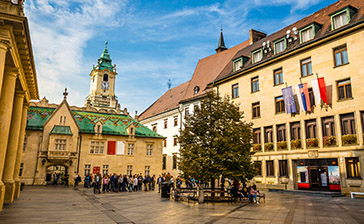
Bratislava Castle: A timeless symbol of the city and the majestic residence of the country’s monarchs for centuries (9th-18th century), the majestic rectangular building complex stands on a rocky hill above the Old Town. The gigantic construction has four towers, one in each corner. The oldest tower (once a vault for the crown jewels) dates back to the 13th century and is 47 meters high, offering an unparalleled view of the city and the neighboring countries of Austria and Hungary. The castle opened its doors in 2010 after an ambitious restoration project that began in 1957, and today it houses the History Museum. Don’t miss out on Maria Theresa’s baroque gardens with the fantastic fountains and statues.
Address: Hrad, 811 06 Bratislava, www.bratislava-hrad.sk.
Blue Church: Built in 1909, St. Elizabeth’s Catholic Church is a wonderful example of Jugendstil (Hungarian Art Nouveau) architecture with a striking blue facade covered with tiles and mosaics. The small one-room structure originally served as the chapel of the school next door and was painted in pastel colors before acquiring its iconic blue color. The interior is equally gorgeous, with blue pews and surfaces clad in handmade majolica tiles, and a blue ceiling. The church is dedicated to a medieval Hungarian princess (and saint) who grew up in Pressburger Castle.
Address: Bezručova 811 09, https://modrykostol.fara.sk/
St. Martin’s Cathedral: A symbol of the city’s splendor at that time (1563-1830), its largest temple was the coronation site of Hungarian kings (and queens), after the destruction of the Székesfehérvár basilica by the Ottomans. This dazzling 15th-century gothic church below the Castle dominates the Old Town’s skyline with its tower, standing 85 meters tall. A gilded replica of the crown jewels adorns the tower’s pyramid roof as a reminder of the glorious times of the past. Every year on 11 November, the day celebrating the patron saint of the city, the first wines of the year’s harvest are offered here.
Address: Rudnayovo námestie 1, 811 01 Bratislava, https://dom.fara.sk/sk/
Danubiana Meulensteen Art Museum: Built on a narrow strip of land that juts into the depths of the Danube, this impressive museum-park looks like a Roman trireme from a distance. The museum is named after the Dutch collector and patron of the arts Gerard H. Meulensteen, donor of the museum’s permanent collection with 200 rare works of abstract contemporary art (paintings, sculptures, photographs, installations). The visitor can admire this collection on the ground floor, while the main hall on the first floor hosts fantastic temporary exhibitions of influential contemporary artists from all over the world. The museum has an art shop and an art café, and the building is surrounded by a park with outdoor sculptures, providing a unique experience for visitors.
Address: Vodné dielo, 851 10 Bratislava-Rusovce, https://danubiana.sk.
Saint Michael’s Gate & Tower: The only preserved gate (out of 4 in total) of the medieval city walls dates back to the 14th century. Its emblematic baroque tower is adorned by a giant statue of Saint Michael and the dragon (1758); today, it houses a small military museum and exhibits documents relating to the walls’ history. The balcony at the top of the tower (51 meters high) offers a unique view of the Old Town and the Bratislava Castle. On the gate’s cobblestone street you can see Bratislava’s “Zero Point”, recording the distance in kilometers to major European capitals.
UFO Tower: Bratislava’s impressive observation deck stands 95 meters tall on the pillars of the SNP bridge and everyone agrees that it looks like a giant flying saucer hovering over the Danube River. The rooftop is home to a bar and restaurant under the UFO brand name, for anyone looking for an unforgettable (and expensive) dining experience with a panoramic view of the city. Take the elevator to the open platform and you will be left speechless before the view, the visibility reaching 100 km. The ultimate spot to watch the sunset.
Address: Most SNP, 851 01 Bratislava, https://www.u-f-o.sk/
Devín Castle: One of the most important historical and archaeological monuments in Central Europe, the medieval castle (9th century) dominates a 212-meter high rock at the confluence of the Danube and the Morava. A maze of courtyards, stairs, walls and the outline of a magnificent Moravian church is all that remains of the grand architectural ensemble after its destruction during the Napoleonic Wars. Its magnificent natural scenery and the unparalleled view of the Austrian bank of the Danube make it a popular destination for hiking, cycling and cultural festivals. The castle is just 10 km west of the center and it can be reached by boat from the port in the city center.
Address: Muránská 1050/10, 841 10 Devín.
Slavín Memorial: The largest war memorial in Central Europe is located on a hilltop behind the castle. The site is the burial place of 6,845 Red Army soldiers who were killed during the liberation of Bratislava in World War II, in April 1945. A favorite area for romantic walks both for residents and visitors, especially at sunset.
Address: Pažického 3, 811 04 Bratislava
The Bronze Sculptures of the Old Town: A series of eccentric bronze human figures on the streets of the Old Town is one of Bratislava’s most photographed sights. The sculptures are a loving and playful tribute to the city’s people and stories over time. The most interesting sculptures are found in the area around the Central Square. Make sure to see Schöne Náci, the suave dandy with a tailcoat, cane and top hat, who became an urban legend with his café presence in the first half of the 20th century. The legendary Čumil Rubberneck, a sewer worker emerging from a manhole, watching the people passing by; Napoleon's soldier bowing politely in front of a bench; the famous storyteller Hans Christian Andersen on Hviezdoslav Square; the paparazzi lurking behind street corners and trees…
Janko Kráľ Park: The oldest public park in Central Europe is a green 42-hectare oasis with rare trees, only a few steps away from the south bank of the Danube River. It is a favorite place for culture and social interaction, sports activities and walking for all ages. Don’t miss out on the beautiful garden pavilion (old Franciscan Church tower). Relax on the lawn and enjoy the view of the Old Town and the Danube after touring the former communist district of Petržalka, known as “Bratislava's Bronx”.
Address: Sad Janka Kráľa, www.sad-janka-krala.sk/
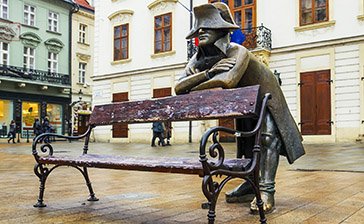
Wander the cobbled streets of the medieval Old Town, where you will discover wonderful fashion boutiques, shops with amazing handmade souvenirs, antique stores, modern concept stores with new designer items, galleries with vintage items and trinkets, wine cellars, pottery and craft workshops. On the Michalská and Ventúrska pedestrian streets you will find excellent ceramics and wooden items.
Buy supolienky (cute handmade corn husk dolls), bryndza cheese, wines, Tatra (a strong tea-based herbal liqueur available in 11 flavors), painted Detva crosses, brightly colored decorative Easter eggs, honey and paprika.
Outside the historic center, the city’s commerce takes place in malls, such as the new and modern Eurovea, on the banks of the Danube River and next to the Apollo Bridge. The state-of-the-art shopping center offers a wide selection of fashion and home design items, restaurants and cafés, while it also hosts open-air Christmas markets, concerts, and sport events. Right beside it, the Riverside Park offers a unique view of the Danube, the bridges and the Petržalka district on the south riverbank. There you will also find the city’s second most popular shopping center, Aupark (with 250 stores) next to Janko Kráľ Park.
For a safari of books, posters, magazines and even LPs, wander around the Bratislava Book Market, which is hosted on Saturdays on the first floor of the Old Market Hall.
Don’t miss out on the historic Miletičova food market, a nostalgic trip to pre-revolutionary Slovakia with an old socialist atmosphere. Browse the food stalls before stopping by the many bistros around it for the best Vietnamese / Asian food in town and the best Langoše (Hungarian street food made from fried potato dough with ketchup and cheese). At Christmas, all roads lead to the Christmas market at the square of the Old Town Hall for varené víno (mulled wine), grog (sweet tea with rum), lokša and traditional souvenirs.
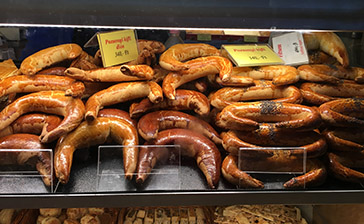
Bratislava’s culinary scene is full of surprises. From the pubs and microbreweries of the Old Town with authentic Central European cuisine to the artistic bistros and trendy bar-restaurants on the promenade by the Danube River (at the Riverside Park and Eurovea), the city’s chefs are constantly winning over the palates of discerning foodies with quality suggestions for both classic and modern cuisine.
The map of flavors stretches across cuisines from all over the world, from Italy and India to Georgia and Asia. Typical city flavors are Bryndzové halušky (a dish with small potato gnocchi andbryndza cheese from sheep’s milk, garnished with pieces of bacon), Kapustnica (sauerkraut soup, with or without sausage), Gulášová polievka (Slovak goulash), Krvavničky (local sausage), bryndzové pirohy (dough crescents filled with bryndza cheese), duck with lokša (a type of potato tortilla greased with goose fat).
If you are craving something sweet, be sure to try Skalický Trdelník (a kind of confectionery / cake made of cylindrical dough in the shape of a chimney, which is baked wrapped around a pole and sprinkled with sugar and cinnamon) and šúľance s makom (potato gnocchi with melted butter, sprinkled with ground poppy seeds and powdered sugar).
For street food lovers, there is nothing better than walking around Stará tržnica (the Old Market building) in SNP Square, where a Street Food Park with dozens of food trucks is set up once a month. On Saturdays, the Trh Piac Market (local farmers’ and producers’ market) is hosted inside the building, where you can taste the unique “buchtáreň” (steamed sweet dumplings). Alternatively, you can find them in the shop under Michael’s Gate.
Before you leave, don't miss out on discovering the wine treasures of the Little Carpathians, a region with a long viticultural and wine-making tradition. You can find extraordinary local white, red and rosé wines on the menus of restaurants as well as stylish wine bars.
For beer lovers, visit the city’s breweries (Meštiansky Pivovar, Richtár Jakub, Patrónsky Pivovar, Starosloviensky Pivovar) to learn the secrets of local beer, or choose popular Slovak labels in beer halls and pubs (Zlatý Bažant, Šariš, Smädný Mních, Topvar, Stein). For alcohol-free fun, you can try Kofola (a light soft drink like Cola), which is also served directly from a barrel (draught), or Vinea (a grape-based soft, white, red or rosé).
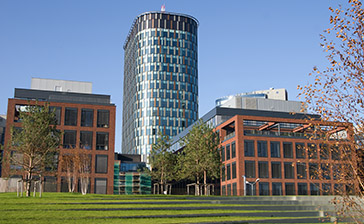
Bratislava Cultural Summer Festival: Bratislava’s biggest cultural event brings every corner of the city to life with concerts, theatre, opera, art, dancing, craft exhibitions, children’s fairy tales, quizzes, chess tournaments, debates and themed city tours. The hub of the celebration, which is already 48 years old, is the Janko Kráľ Park. From June to September.
Dni Majstrov (Craftsmen Days Festival): Artisans honor the city’s great craft tradition with a three-day celebration of arts and crafts all over the city center. The program includes demonstrations by craftsmen, workshops, culinary tastings, traditional music and dancing. The festival has been held since 1990 and it takes place in late August.
Bratislava Coronation Days: Every June, Bratislava symbolically revives its glorious past as Pressburg, capital of the Kingdom of Hungary and coronation site of Hungarian kings (1563-1830). At the heart of the three-day festivities is the re-enactment of the coronation ceremony with a spectacular royal procession (with actors in period costumes) on the streets from the Castle to the main square. The program also includes fencing matches between knights, falcon shows, craft demonstrations and a historic “old-time” market.
Slovak Food Fest: For three days every May, the best chefs of the best restaurants in the city invite residents and visitors alike to the biggest annual picnic on the lawns of Bratislava Castle. The tastings of traditional Slovak and international cuisine are complemented by culinary demonstrations, competitions, educational workshops for children, eco-friendly discussions and wine evenings under the sounds of jazz.
Bratislava Music Festival: The biggest classical music festival in the city with a deep-rooted long tradition. The top “rendezvous” of classical music lovers for 52 years, it is organized by the famous Slovak Philharmonic and includes symphonic and chamber music concerts. September and October.
Bratislava Jazz Days: Every October, jazz music lovers can enjoy an international 4-day concert with leading as well as up-and-coming names in the genre from all over the world. There is something for every taste, from Big Band, Hot and Cool jazz to alternative jazz.
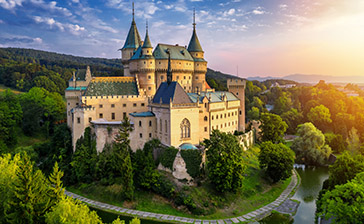
Travel from the airport to the city
M.R. Štefánik Airport or Bratislava Airport (BTS) is 9 km northeast of the center of Bratislava. The airport is connected to the city center by bus, or by bus and tram. The cheapest way to get to the city is to take bus line No61 (Letisko – Hlavná Stanica) which connects the airport (Letisko) with the Central Railway Station (Hlavná Stanica) on a daily basis (from 4.00 to 23.35, every 13-30 minutes depending on rush hours) or the N61 night line (from 23.52 to 3.52, departing every hour). From here you will take bus No93 to Petržalka, Vyšehradská (4.40 - 23.08, every 10-15 minutes) to the stop “Hodžovo námestie” (Hodžovo central square) next to the Presidential Palace.
Alternatively, you can take tram line No1 towards Nám. Ľ. Štúra (4.40-0.00, every 4-10 minutes) and get off at the stop “Centrum” in front of the SNP Central Square (Námestie SNP) or Jesenského (at the historic Slovak National Theatre).
If you choose to travel by train, the city center is only 1.7 km from the Railway Station and it is easily traversed on foot. The journey from the airport to the Central Railway Station takes 20 minutes (30 minutes during rush hour) and another 15 minutes to the city center. Tickets are sold in the vending machines found at bus stops and are validated on the bus. More information is available at https://imhd.sk.
Taxis are quite cheap in Bratislava and you can choose one of the two official airport taxi service partners. The station is located in front of arrivals and the charges according to the destination are clearly and prominently displayed. Depending on traffic, the journey to the city center takes between 15 and 30 minutes.

Bratislava Castle: A timeless symbol of the city and the majestic residence of the country’s monarchs for centuries (9th-18th century), the majestic rectangular building complex stands on a rocky hill above the Old Town. The gigantic construction has four towers, one in each corner. The oldest tower (once a vault for the crown jewels) dates back to the 13th century and is 47 meters high, offering an unparalleled view of the city and the neighboring countries of Austria and Hungary. The castle opened its doors in 2010 after an ambitious restoration project that began in 1957, and today it houses the History Museum. Don’t miss out on Maria Theresa’s baroque gardens with the fantastic fountains and statues.
Address: Hrad, 811 06 Bratislava, www.bratislava-hrad.sk.
Blue Church: Built in 1909, St. Elizabeth’s Catholic Church is a wonderful example of Jugendstil (Hungarian Art Nouveau) architecture with a striking blue facade covered with tiles and mosaics. The small one-room structure originally served as the chapel of the school next door and was painted in pastel colors before acquiring its iconic blue color. The interior is equally gorgeous, with blue pews and surfaces clad in handmade majolica tiles, and a blue ceiling. The church is dedicated to a medieval Hungarian princess (and saint) who grew up in Pressburger Castle.
Address: Bezručova 811 09, https://modrykostol.fara.sk/
St. Martin’s Cathedral: A symbol of the city’s splendor at that time (1563-1830), its largest temple was the coronation site of Hungarian kings (and queens), after the destruction of the Székesfehérvár basilica by the Ottomans. This dazzling 15th-century gothic church below the Castle dominates the Old Town’s skyline with its tower, standing 85 meters tall. A gilded replica of the crown jewels adorns the tower’s pyramid roof as a reminder of the glorious times of the past. Every year on 11 November, the day celebrating the patron saint of the city, the first wines of the year’s harvest are offered here.
Address: Rudnayovo námestie 1, 811 01 Bratislava, https://dom.fara.sk/sk/
Danubiana Meulensteen Art Museum: Built on a narrow strip of land that juts into the depths of the Danube, this impressive museum-park looks like a Roman trireme from a distance. The museum is named after the Dutch collector and patron of the arts Gerard H. Meulensteen, donor of the museum’s permanent collection with 200 rare works of abstract contemporary art (paintings, sculptures, photographs, installations). The visitor can admire this collection on the ground floor, while the main hall on the first floor hosts fantastic temporary exhibitions of influential contemporary artists from all over the world. The museum has an art shop and an art café, and the building is surrounded by a park with outdoor sculptures, providing a unique experience for visitors.
Address: Vodné dielo, 851 10 Bratislava-Rusovce, https://danubiana.sk.
Saint Michael’s Gate & Tower: The only preserved gate (out of 4 in total) of the medieval city walls dates back to the 14th century. Its emblematic baroque tower is adorned by a giant statue of Saint Michael and the dragon (1758); today, it houses a small military museum and exhibits documents relating to the walls’ history. The balcony at the top of the tower (51 meters high) offers a unique view of the Old Town and the Bratislava Castle. On the gate’s cobblestone street you can see Bratislava’s “Zero Point”, recording the distance in kilometers to major European capitals.
UFO Tower: Bratislava’s impressive observation deck stands 95 meters tall on the pillars of the SNP bridge and everyone agrees that it looks like a giant flying saucer hovering over the Danube River. The rooftop is home to a bar and restaurant under the UFO brand name, for anyone looking for an unforgettable (and expensive) dining experience with a panoramic view of the city. Take the elevator to the open platform and you will be left speechless before the view, the visibility reaching 100 km. The ultimate spot to watch the sunset.
Address: Most SNP, 851 01 Bratislava, https://www.u-f-o.sk/
Devín Castle: One of the most important historical and archaeological monuments in Central Europe, the medieval castle (9th century) dominates a 212-meter high rock at the confluence of the Danube and the Morava. A maze of courtyards, stairs, walls and the outline of a magnificent Moravian church is all that remains of the grand architectural ensemble after its destruction during the Napoleonic Wars. Its magnificent natural scenery and the unparalleled view of the Austrian bank of the Danube make it a popular destination for hiking, cycling and cultural festivals. The castle is just 10 km west of the center and it can be reached by boat from the port in the city center.
Address: Muránská 1050/10, 841 10 Devín.
Slavín Memorial: The largest war memorial in Central Europe is located on a hilltop behind the castle. The site is the burial place of 6,845 Red Army soldiers who were killed during the liberation of Bratislava in World War II, in April 1945. A favorite area for romantic walks both for residents and visitors, especially at sunset.
Address: Pažického 3, 811 04 Bratislava
The Bronze Sculptures of the Old Town: A series of eccentric bronze human figures on the streets of the Old Town is one of Bratislava’s most photographed sights. The sculptures are a loving and playful tribute to the city’s people and stories over time. The most interesting sculptures are found in the area around the Central Square. Make sure to see Schöne Náci, the suave dandy with a tailcoat, cane and top hat, who became an urban legend with his café presence in the first half of the 20th century. The legendary Čumil Rubberneck, a sewer worker emerging from a manhole, watching the people passing by; Napoleon's soldier bowing politely in front of a bench; the famous storyteller Hans Christian Andersen on Hviezdoslav Square; the paparazzi lurking behind street corners and trees…
Janko Kráľ Park: The oldest public park in Central Europe is a green 42-hectare oasis with rare trees, only a few steps away from the south bank of the Danube River. It is a favorite place for culture and social interaction, sports activities and walking for all ages. Don’t miss out on the beautiful garden pavilion (old Franciscan Church tower). Relax on the lawn and enjoy the view of the Old Town and the Danube after touring the former communist district of Petržalka, known as “Bratislava's Bronx”.
Address: Sad Janka Kráľa, www.sad-janka-krala.sk/

Wander the cobbled streets of the medieval Old Town, where you will discover wonderful fashion boutiques, shops with amazing handmade souvenirs, antique stores, modern concept stores with new designer items, galleries with vintage items and trinkets, wine cellars, pottery and craft workshops. On the Michalská and Ventúrska pedestrian streets you will find excellent ceramics and wooden items.
Buy supolienky (cute handmade corn husk dolls), bryndza cheese, wines, Tatra (a strong tea-based herbal liqueur available in 11 flavors), painted Detva crosses, brightly colored decorative Easter eggs, honey and paprika.
Outside the historic center, the city’s commerce takes place in malls, such as the new and modern Eurovea, on the banks of the Danube River and next to the Apollo Bridge. The state-of-the-art shopping center offers a wide selection of fashion and home design items, restaurants and cafés, while it also hosts open-air Christmas markets, concerts, and sport events. Right beside it, the Riverside Park offers a unique view of the Danube, the bridges and the Petržalka district on the south riverbank. There you will also find the city’s second most popular shopping center, Aupark (with 250 stores) next to Janko Kráľ Park.
For a safari of books, posters, magazines and even LPs, wander around the Bratislava Book Market, which is hosted on Saturdays on the first floor of the Old Market Hall.
Don’t miss out on the historic Miletičova food market, a nostalgic trip to pre-revolutionary Slovakia with an old socialist atmosphere. Browse the food stalls before stopping by the many bistros around it for the best Vietnamese / Asian food in town and the best Langoše (Hungarian street food made from fried potato dough with ketchup and cheese). At Christmas, all roads lead to the Christmas market at the square of the Old Town Hall for varené víno (mulled wine), grog (sweet tea with rum), lokša and traditional souvenirs.

Bratislava’s culinary scene is full of surprises. From the pubs and microbreweries of the Old Town with authentic Central European cuisine to the artistic bistros and trendy bar-restaurants on the promenade by the Danube River (at the Riverside Park and Eurovea), the city’s chefs are constantly winning over the palates of discerning foodies with quality suggestions for both classic and modern cuisine.
The map of flavors stretches across cuisines from all over the world, from Italy and India to Georgia and Asia. Typical city flavors are Bryndzové halušky (a dish with small potato gnocchi andbryndza cheese from sheep’s milk, garnished with pieces of bacon), Kapustnica (sauerkraut soup, with or without sausage), Gulášová polievka (Slovak goulash), Krvavničky (local sausage), bryndzové pirohy (dough crescents filled with bryndza cheese), duck with lokša (a type of potato tortilla greased with goose fat).
If you are craving something sweet, be sure to try Skalický Trdelník (a kind of confectionery / cake made of cylindrical dough in the shape of a chimney, which is baked wrapped around a pole and sprinkled with sugar and cinnamon) and šúľance s makom (potato gnocchi with melted butter, sprinkled with ground poppy seeds and powdered sugar).
For street food lovers, there is nothing better than walking around Stará tržnica (the Old Market building) in SNP Square, where a Street Food Park with dozens of food trucks is set up once a month. On Saturdays, the Trh Piac Market (local farmers’ and producers’ market) is hosted inside the building, where you can taste the unique “buchtáreň” (steamed sweet dumplings). Alternatively, you can find them in the shop under Michael’s Gate.
Before you leave, don't miss out on discovering the wine treasures of the Little Carpathians, a region with a long viticultural and wine-making tradition. You can find extraordinary local white, red and rosé wines on the menus of restaurants as well as stylish wine bars.
For beer lovers, visit the city’s breweries (Meštiansky Pivovar, Richtár Jakub, Patrónsky Pivovar, Starosloviensky Pivovar) to learn the secrets of local beer, or choose popular Slovak labels in beer halls and pubs (Zlatý Bažant, Šariš, Smädný Mních, Topvar, Stein). For alcohol-free fun, you can try Kofola (a light soft drink like Cola), which is also served directly from a barrel (draught), or Vinea (a grape-based soft, white, red or rosé).

Bratislava Cultural Summer Festival: Bratislava’s biggest cultural event brings every corner of the city to life with concerts, theatre, opera, art, dancing, craft exhibitions, children’s fairy tales, quizzes, chess tournaments, debates and themed city tours. The hub of the celebration, which is already 48 years old, is the Janko Kráľ Park. From June to September.
Dni Majstrov (Craftsmen Days Festival): Artisans honor the city’s great craft tradition with a three-day celebration of arts and crafts all over the city center. The program includes demonstrations by craftsmen, workshops, culinary tastings, traditional music and dancing. The festival has been held since 1990 and it takes place in late August.
Bratislava Coronation Days: Every June, Bratislava symbolically revives its glorious past as Pressburg, capital of the Kingdom of Hungary and coronation site of Hungarian kings (1563-1830). At the heart of the three-day festivities is the re-enactment of the coronation ceremony with a spectacular royal procession (with actors in period costumes) on the streets from the Castle to the main square. The program also includes fencing matches between knights, falcon shows, craft demonstrations and a historic “old-time” market.
Slovak Food Fest: For three days every May, the best chefs of the best restaurants in the city invite residents and visitors alike to the biggest annual picnic on the lawns of Bratislava Castle. The tastings of traditional Slovak and international cuisine are complemented by culinary demonstrations, competitions, educational workshops for children, eco-friendly discussions and wine evenings under the sounds of jazz.
Bratislava Music Festival: The biggest classical music festival in the city with a deep-rooted long tradition. The top “rendezvous” of classical music lovers for 52 years, it is organized by the famous Slovak Philharmonic and includes symphonic and chamber music concerts. September and October.
Bratislava Jazz Days: Every October, jazz music lovers can enjoy an international 4-day concert with leading as well as up-and-coming names in the genre from all over the world. There is something for every taste, from Big Band, Hot and Cool jazz to alternative jazz.

Transport from the airport
M.R. Štefánik Airport or Bratislava Airport (BTS) is 9 km northeast of the center of Bratislava. The airport is connected to the city center by bus, or by bus and tram. The cheapest way to get to the city is to take bus line No61 (Letisko – Hlavná Stanica) which connects the airport (Letisko) with the Central Railway Station (Hlavná Stanica) on a daily basis (from 4.00 to 23.35, every 13-30 minutes depending on rush hours) or the N61 night line (from 23.52 to 3.52, departing every hour). From here you will take bus No93 to Petržalka, Vyšehradská (4.40 - 23.08, every 10-15 minutes) to the stop “Hodžovo námestie” (Hodžovo central square) next to the Presidential Palace.
Alternatively, you can take tram line No1 towards Nám. Ľ. Štúra (4.40-0.00, every 4-10 minutes) and get off at the stop “Centrum” in front of the SNP Central Square (Námestie SNP) or Jesenského (at the historic Slovak National Theatre).
If you choose to travel by train, the city center is only 1.7 km from the Railway Station and it is easily traversed on foot. The journey from the airport to the Central Railway Station takes 20 minutes (30 minutes during rush hour) and another 15 minutes to the city center. Tickets are sold in the vending machines found at bus stops and are validated on the bus. More information is available at https://imhd.sk.
Taxis are quite cheap in Bratislava and you can choose one of the two official airport taxi service partners. The station is located in front of arrivals and the charges according to the destination are clearly and prominently displayed. Depending on traffic, the journey to the city center takes between 15 and 30 minutes.

